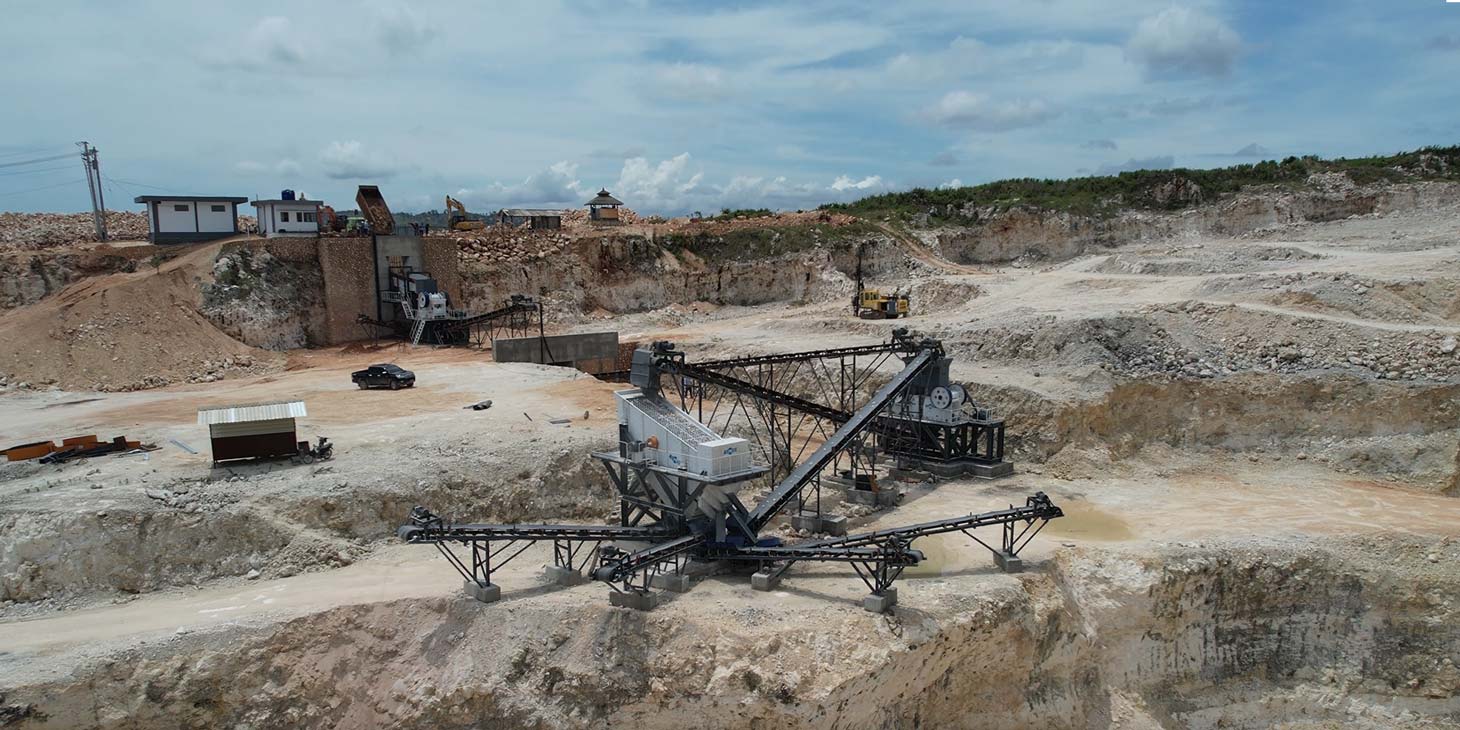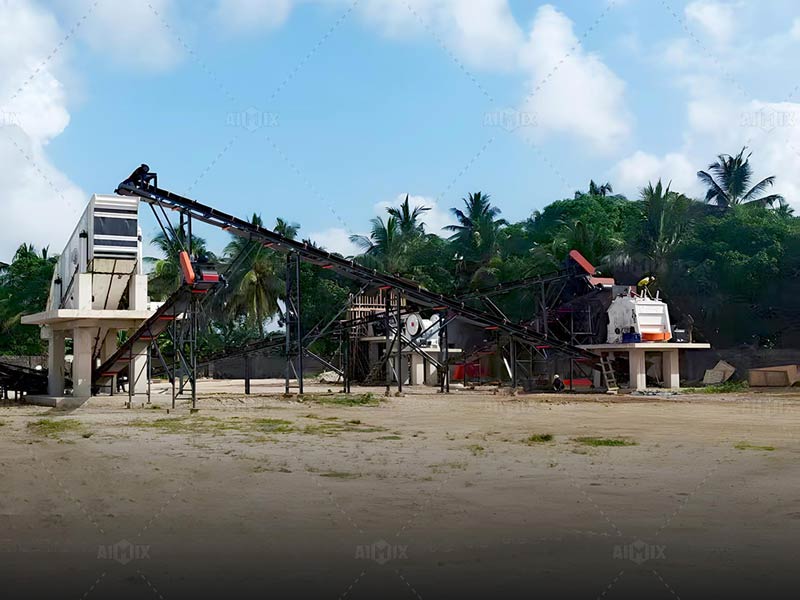A 100 TPH limestone crushing plant stands at the intersection of efficiency and precision. It is not merely a collection of heavy-duty machines, but an orchestrated system designed to transform solid rock into construction-grade aggregate.
Each component—from feeder to screen—must operate in harmony to maintain productivity, energy efficiency, and desired output gradation. Understanding its crushing plant setup reveals how modern crushing systems achieve both cost efficiency and consistent product quality.
I. Core Equipment in a 100 TPH Limestone Crushing Line
Every limestone crushing plant begins with a strategic selection of core machinery. These machines determine the rhythm of production and directly influence operational longevity. The 100 TPH configuration demands equipment capable of steady throughput without sacrificing crushing precision or maintenance simplicity.
1. Vibrating Feeder: The Flow Regulator
The process starts with a vibrating feeder—an unsung hero that ensures a controlled, consistent flow of raw limestone into the primary crusher. It eliminates surges, reduces wear on downstream equipment, and maintains a steady feed rate crucial for uniform crushing. In well-optimized plants, feeders are often equipped with adjustable speed drives and grizzly bars to pre-screen fines, allowing the crusher to focus solely on larger chunks of material.

2. Primary Crusher: Jaw or Impact Configuration
At the heart of the system lies the primary crusher, usually a robust jaw crusher or a high-efficiency impact crusher. The choice hinges on the project’s aggregate specifications. Jaw crushers excel in handling hard limestone with minimal dust production, while impact crushers provide superior shaping and flexibility for variable rock hardness. For a 100 TPH setup, the selected unit must balance capacity and reduction ratio, transforming raw limestone into manageable 0–100 mm fragments for secondary processing.
3. Secondary Crusher: Fine-Tuning the Output
The secondary stage refines the material. Here, cone crushers or vertical shaft impactors (VSI) are employed to achieve precise grain sizes and cubicity. Cone crushers, with their laminated crushing principle, minimize over-crushing and preserve particle integrity. VSIs, conversely, deliver sharper edges—ideal for producing fine aggregates for concrete and asphalt. This layer of the process dictates the quality of the final product.
4. Vibrating Screen and Conveyor System
Once the crushing is complete, a vibrating screen classifies the material into various fractions. Multiple decks separate aggregates into 0–5 mm, 5–10 mm, and 10–20 mm sizes, ensuring conformity with market standards. Conveyors link each stage seamlessly, creating an uninterrupted material circuit. The design must balance belt speed, width, and angle to prevent spillage and preserve throughput consistency.

II. Flow Design for Balanced Production
Flow design is not just about connecting machines—it’s the art of achieving synergy. A well-designed flow minimizes idle time, reduces power consumption, and optimizes space utilization. The 100 TPH limestone crusher machine plant thrives on calculated alignment, where every ton of rock follows a predictable, optimized journey from entry to exit.
1. Material Pathway and Layout Planning
A linear or L-shaped flow arrangement is typical for compact installations. The raw limestone moves from the feeding zone to the primary and secondary crushers, then onto the screening section. Each transition is engineered to reduce handling distance. Proper elevation design ensures gravity-assisted movement, lessening conveyor strain and lowering operational energy demand.
2. Dust Suppression and Noise Control Measures
Crushing limestone inevitably releases dust, a nuisance both environmentally and operationally. Incorporating water mist systems, sealed transfer points, and enclosure covers preserves air quality while safeguarding worker health. Noise barriers, rubber-lined chutes, and vibration isolators maintain a quieter, safer workplace. Sustainable flow design isn’t just about productivity—it’s also about environmental stewardship.
3. Energy Optimization through Smart Controls
Automation transforms plant flow into an intelligent ecosystem. Programmable Logic Controllers (PLC) monitor feed rates, motor loads, and power consumption in real time. Automated shutoffs prevent overload, while synchronized operation among feeders, crushers, and screens ensures seamless coordination. These digital controls can improve energy efficiency by up to 20%, aligning productivity with sustainability goals.
III. Output Control and Performance Calibration
Once operational, the 100 TPH limestone plant must maintain a steady output, day after day. Controlling product size, shape, and consistency requires both mechanical precision and analytical feedback. Continuous performance evaluation keeps the plant aligned with production goals.
1. Aggregate Quality Monitoring
Sampling systems at discharge points measure gradation, moisture content, and shape distribution. Deviations trigger adjustments in crusher settings or screen apertures. Real-time analytics ensure each batch meets the required specifications, guaranteeing client satisfaction and regulatory compliance.
2. Equipment Maintenance and Wear Management
The rhythm of a crushing plant depends on maintenance discipline. Wear liners, belts, and screens degrade over time, subtly altering performance. Predictive maintenance—guided by vibration sensors and thermal imaging—identifies wear before failure occurs. Such foresight extends equipment life and minimizes downtime, safeguarding the plant’s consistent 100 TPH output.
3. Output Adjustment for Market Demand
Flexibility defines profitability. When market needs shift—from road base to concrete-grade aggregates—the plant can adapt by modifying crusher CSS (closed side setting) or screen mesh sizes. This modular adaptability keeps the operation economically resilient, able to respond swiftly to evolving customer demands without structural overhaul.
Conclusion
A 100 TPH limestone rock crushing plant epitomizes precision engineering. Each machine, each conveyor, each control unit contributes to a larger rhythm of transformation—from solid bedrock to valuable construction aggregate. The real mastery lies in orchestrating balance: between capacity and quality, automation and human insight, output and sustainability. When these elements converge, the plant becomes more than machinery—it becomes a living system, continuously producing, adapting, and evolving.
